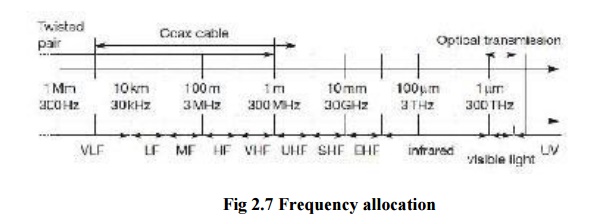Chapter: Mobile Networks : Cellular Wireless Network
Frequency Allocation
FREQUENCY ALLOCATION:
Radio
transmission can take place using many different frequency bands. Each
frequency band exhibits certain advantages and disadvantages. Figure gives a
rough overview of the frequency spectrum that can be used for data
transmission. The figure shows frequencies starting at 300 Hz and going up to
over 300 THz. Directly coupled to the frequency is the wavelength λ
via the equation: λ = c/f, where c ≅ 3·108 m/s (the speed of light in vacuum) and f the frequency. For traditional wired
networks, frequencies of up to several hundred kHz are used for distances up to
some km with twisted pair copper wires, while frequencies of several hundred
MHz are used with coaxial cable (new coding schemes work with several hundred
MHz even with twisted pair copper wires over distances of some 100 m).

Fiber
optics are used for frequency ranges of several hundred THz, but here one
typically refers to the wavelength which is, e.g., 1500 nm, 1350 nm etc. (infra
red). Radio transmission starts at several kHz, the very low frequency (VLF) range.
These are very long waves. Waves in the
low frequency (LF) range are
used by submarines, because they can penetrate water and can follow the earth‟s
surface. Some radio stations still use these frequencies, e.g., between
148.5 kHz
and 283.5 kHz in Germany. The medium
frequency (MF) and high frequency (HF) ranges are typical for
transmission of hundreds of radio stations
either as amplitude modulation (AM)
between 520 kHz and 1605.5 kHz, as short wave (SW) between 5.9 MHz and 26.1 MHz, or as frequency modulation (FM) between 87.5 MHz and 108 MHz. The
frequencies limiting these ranges are typically fixed by national regulation
and, vary from country to country. Short waves are typically used for (amateur)
radio transmission around the world, enabled by reflection at the ionosphere
.
Transmit power is up to 500 kW – which is quite high compared to the 1 W of a
mobile phone. As we move to higher frequencies, the TV stations follow.
Conventional analog TV is transmitted in ranges of 174–230 MHz and 470–790 MHz
using the very high frequency (VHF) and
ultra high frequency (UHF) bands. In
this range, digital audio broadcasting (DAB) takes place as well (223–230 MHz and 1452–1472 MHz) and
digital TV is planned or currently being installed (470– 862 MHz), reusing some
of the old frequencies for analog TV. UHF is also used for mobile phones with
analog technology (450–465 MHz), the digital GSM (890–960 MHz, 1710–1880 MHz),
digital cordless telephones following the DECT standard (1880–1900 MHz), 3G
cellular systems following the UMTS standard (1900–1980 MHz, 2020–2025 MHz,
2110–2190 MHz) and many more. VHF and especially
UHF allow
for small antennas and relatively reliable connections for mobile telephony. Super high frequencies (SHF) are
typically used for directed microwave links (approx. 2–40 GHz) and fixed
satellite services in the C-band (4 and 6 GHz), Ku-band (11 and 14 GHz), or
Ka-band (19 and 29 GHz). Some systems are planned in the extremely high frequency (EHF) range which comes close to infra
red. All radio frequencies are regulated to avoid interference, e.g., the
German regulation covers 9 kHz–275 GHz. The next step into higher frequencies
involves optical transmission, which is not only used for fiber optical links
but also for wireless communications. Infra
red (IR) transmission is used for directed links, e.g., to connect
different buildings via laser links. The most widespread IR technology, infra
red data association (IrDA), uses wavelengths of approximately 850–900 nm to
connect laptops, PDAs etc. Finally, visible light has been used for wireless
transmission for thousands of years. While light is not very reliable due to
interference, but it is nevertheless useful due to built-in human receivers.
Powered by
Related Topics